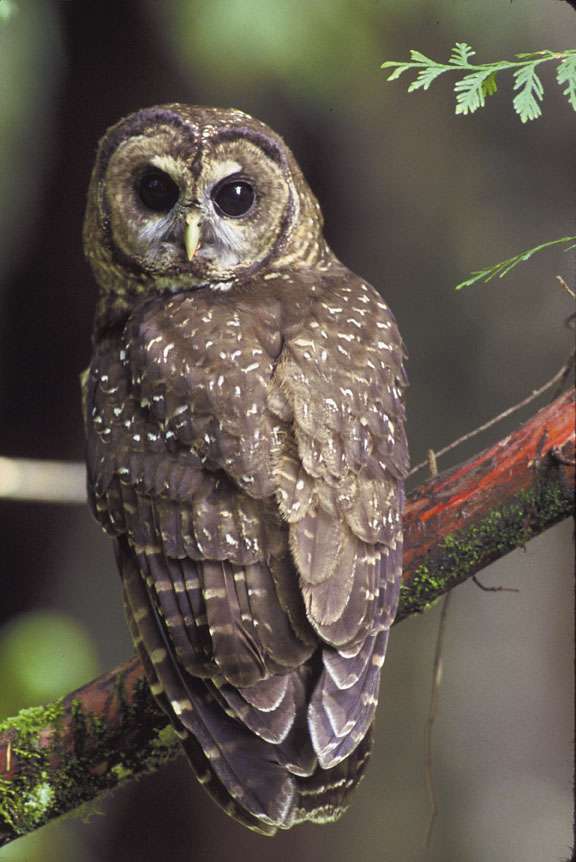- Catalog No. —
- WO 5490
- Date —
- c. 2002
- Era —
- 1981-Present (Recent Oregon History)
- Themes —
- Environment and Natural Resources, Government, Law, and Politics, Trade, Business, Industry, and the Economy
- Credits —
- U.S. Fish and Wildlife�
- Regions —
- Cascades Coast
- Author —
- John and Karen Hollingsworth
Northern Spotted Owl
This photograph was taken by a U.S. Fish and Wildlife photographer around 2002. It shows a northern spotted owl (Strix occidentalis caurina) perched on a tree branch in Oregon’s McKenzie River Basin.
The northern spotted owl is one of three subspecies of spotted owl present in western North America. They are found in northwestern California, western Oregon, western Washington, and southwestern British Columbia. Spotted owls prefer mature and old-growth forests in which to establish their nests. This preference for old forests has made them vulnerable to habitat disturbance caused by modern forestry practices.
The first indication that spotted owl populations were in decline came in the 1970s when research by Oregon State University graduate student Eric Forsman indicated that spotted owl populations were being threatened with extinction by extensive cutting of old-growth forests. The state of Oregon listed the spotted owl as “threatened” in 1975, but the U.S. Fish and Wildlife Service (USFWS) concluded that a listing under the federal Endangered Species Act was not warranted. They considered the spotted owl to be a “vulnerable species,” but not threatened with imminent extinction.
In 1987 a number of environmental groups petitioned the USFWS to list the spotted owl as endangered under the Endangered Species Act. The USFWS again determined that a listing was not warranted, a decision that environmental groups challenged in court. The agency reconsidered its decision and in April 1989 found that a “threatened” listing was warranted. The owl was officially listed as threatened on July 23, 1990. Federal timber sales were drastically cut after the listing and a subsequent lawsuit, dropping from a 1983-1989 average of 2.9 billion board-feet in western Oregon to less than 0.5 billion board-feet in 1996.
There has been a great deal of debate over what impact the spotted owl listing has had on Oregon’s economy. Some scholars and timber industry representatives have argued that tens of thousands of jobs were lost because of spotted owl protection measures. The 1992 federal draft recovery plan, for example, estimated that the region would lose 18,900 jobs in the timber industry and another 13,200 jobs in related sectors due to implementation of recovery measures.
Other scholars, as well as many environmentalists, have argued that the economic impact of the listing has been exaggerated. They maintain that the loss of thousands of timber industry jobs during the 1990s was the result of long-term processes related to the inherent instability of the timber industry, industry restructuring, and overcutting of old-growth on both public and private lands.
Further Reading:
Freudenburg, William R., Lisa J. Wilson, and Daniel J. O'Leary. “Forty Years of Spotted Owls? A Longitudinal Analysis of Logging Industry Job Losses.” Sociological Perspectives 41 (1998): 1-26.
Yaffee, Steven Lewis. Wisdom of the Spotted Owl: Policy Lessons for a New Century. Washington, D.C., 1994.
Written by Cain Allen, © Oregon Historical Society, 2006.
